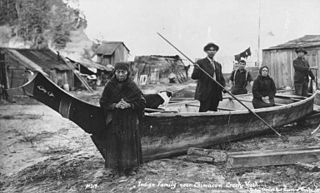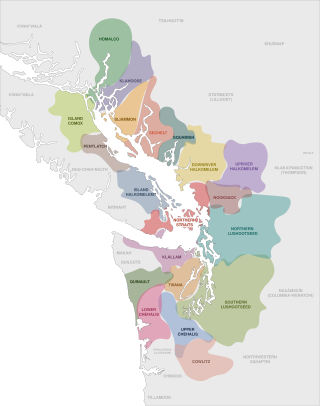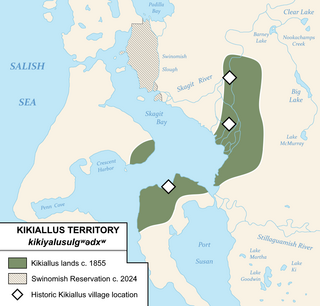Related Research Articles

The Salishan languages are a family of languages of the Pacific Northwest in North America. They are characterised by agglutinativity and syllabic consonants. For instance the Nuxalk word clhp’xwlhtlhplhhskwts’, meaning "he had had [in his possession] a bunchberry plant", has twelve obstruent consonants in a row with no phonetic or phonemic vowels.

The Skokomish are one of nine tribes of the Twana, a Native American people of western Washington state in the United States. The tribe lives along Hood Canal, a fjord-like inlet on the west side of the Kitsap Peninsula and the Puget Sound basin. Historically the Twana were hunters, fishers, and gatherers who had a nomadic lifestyle during the warmer months, while living in more permanent homes during the winter months.

The Duwamish are a Lushootseed-speaking Southern Coast Salish people in western Washington, and the Indigenous people of metropolitan Seattle.

The Klallam are a Coast Salish people Indigenous to the northern Olympic Peninsula. The language of the Klallam is the Klallam language, a language closely related to the North Straits Salish languages. The Klallam are today citizens of four recognized bands: Three federally-recognized tribes in the United States and one band government in Canada. Two Klallam tribes, the Jamestown S'Klallam and Lower Elwha Klallam, live on the Olympic Peninsula, and one, the Port Gamble S'Klallam, on the Kitsap Peninsula in Washington state. In Canada, the Scia'new First Nation is based at Becher Bay on southern Vancouver Island in British Columbia.

The Swinomishpeople are a Lushootseed-speaking people Indigenous to western Washington state.
Lushootseed, historically known as Puget Salish, Puget Sound Salish, or Skagit-Nisqually, is a Central Coast Salish language of the Salishan language family. Lushootseed is the general name for the dialect continuum composed of two main dialects, Northern Lushootseed and Southern Lushootseed, which are further separated into smaller sub-dialects.

The Coast Salish languages, also known as the Central Salish languages, are a branch of the Salishan language family. These languages are spoken by First Nations or Native American peoples inhabiting the Pacific Northwest, in the territory that is now known as the southwest coast of British Columbia around the Strait of Georgia and Washington State around Puget Sound. The term "Coast Salish" also refers to the cultures in British Columbia and Washington who speak one of these languages or dialects.

The Skokomish River is a river in Mason County, Washington, United States. It is the largest river flowing into Hood Canal, a western arm of Puget Sound. From its source at the confluence of the North and South Forks the main stem Skokomish River is approximately 9 miles (14 km) long. The longer South Fork Skokomish River is 40 miles (64 km), making the length of the whole river via its longest tributary about 49 miles (79 km). The North Fork Skokomish River is approximately 34 miles (55 km) long. A significant part of the Skokomish River's watershed is within Olympic National Forest and Olympic National Park.

The Chimakum, also spelled Chemakum and Chimacum Native American people, were a group of Native Americans who lived in the northeastern portion of the Olympic Peninsula in Washington state, between Hood Canal and Discovery Bay until their virtual extinction in 1902. Their primary settlements were on Port Townsend Bay, on the Quimper Peninsula, and Port Ludlow Bay to the south.

Twana is the collective name for a group of nine Coast Salish peoples in the northern-mid Puget Sound region. The Skokomish are the main surviving group and self-identify as the Twana today. The spoken language, also named Twana, is part of the Central Coast Salish language group. The Twana language is closely related to Lushootseed.
The Samish are a Native American people who live in the U.S. state of Washington. They are a Central Coast Salish people. Through the years, they were assigned to reservations dominated by other Tribes, for instance, the Swinomish Indians of the Swinomish Reservation of Washington and the Tulalip Tribes of the Tulalip Reservation. They are also enrolled in the Samish Indian Nation, formerly known as the Samish Indian Tribe, which regained federal recognition in 1996.
The Sammamish people are a Lushootseed-speaking Southern Coast Salish people. They are indigenous to the Sammamish River Valley in central King County, Washington. The Sammamish speak Lushootseed, a Coast Salish language which was historically spoken across most of Puget Sound, although its usage today is mostly reserved for cultural and ceremonial practices.

The Coast Salish are a group of ethnically and linguistically related Indigenous peoples of the Pacific Northwest Coast, living in the Canadian province of British Columbia and the U.S. states of Washington and Oregon. They speak one of the Coast Salish languages. The Nuxalk nation are usually included in the group, although their language is more closely related to Interior Salish languages.
The Lower Skagit are a tribe of the Lushootseed Native American people living in the U.S. state of Washington. Today they are enrolled in the federally recognized tribe, the Swinomish Indians of the Swinomish Reservation.

The Pilchuck River is a river in Snohomish County in the U.S. state of Washington. It is a tributary of the Snohomish River. The name is derived from the Chinook Jargon pilpil and chuck ("water"), or "red water". The Lushootseed name means "flowing red," kʷiƛ̕ being an archaic term for "red" in Northern Lushootseed.

The Salish peoples are indigenous peoples of the American and Canadian Pacific Northwest, identified by their use of the Salishan languages which diversified out of Proto-Salish between 3,000 and 6,000 years ago.

The Skokomish Indian Tribe, formerly known as the Skokomish Indian Tribe of the Skokomish Reservation, and in its own official use the Skokomish Tribal Nation, is a federally recognized tribe of Skokomish, Twana, Klallam, and Chimakum people. They are a tribe of Southern Coast Salish indigenous people of the Pacific Northwest located in Washington. The Skokomish are one of nine bands of Twana people.

The Kikiallus people are a Lushootseed-speaking Coast Salish people Indigenous to parts of western Washington.
Lake Nahwatzel is a body of freshwater located in Mason County in the U.S. state of Washington. The lake is fed by three main sources, which include two unnamed creeks and naturally occurring hot springs. The lake empties into the East Fork of the Satsop River via Outlet Creek. Lake Nahwatzel is one of the warmest lakes in western Washington due to the presence of the aforementioned hot springs. Nearby towns include Shelton and Matlock.
The Steilacoompeople are Lushootseed-speaking Southern Coast Salish people, indigenous to the southern Puget Sound region of Washington state.
References
- 1 2 3 Twana at Ethnologue (18th ed., 2015) (subscription required)
- 1 2 3 Drachman, Gaberell (2020). tuwaduq: The Twana Language E-Dictionary Project (PDF). Skokomish Indian Tribe.
- ↑ Bright, William (2004). Native American Placenames of the United States. University of Oklahoma Press. p. 452. ISBN 978-0-8061-3598-4 . Retrieved 3 November 2010.
- ↑ Wray, Jacilee (2003). "Skokomish: Twana Descendants". Native Peoples of the Olympic Peninsula: Who We Are. University of Oklahoma Press. p. 65. ISBN 978-0-8061-3552-6 . Retrieved 3 November 2010.
- ↑ The Skokomish Tribal Nation
- ↑ Drachman, Gaberell (1969). Twana Phonology. Department of Linguistics, Ohio State University.